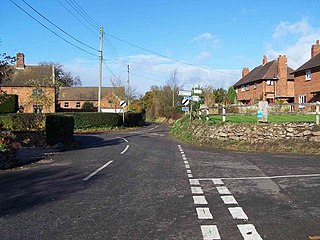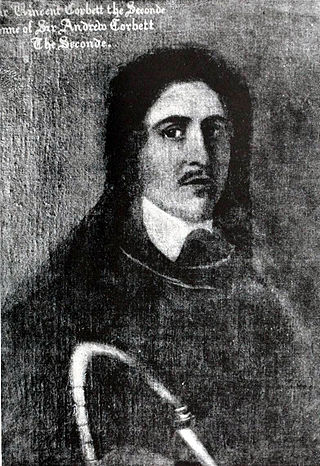
Shawbury is a village and civil parish in the English county of Shropshire. The village is 8.4 miles (13.5 km) northeast of the town of Shrewsbury, 11.5 miles (18.5 km) northwest of Telford and 163 miles (262 km) northwest of London.

Little Stretton is a village and former civil parish, now in the parish of Church Stretton, in the Shropshire district, in the ceremonial county of Shropshire, England. In 1961 the parish had a population of 80. Little Stretton became a civil parish in 1899 being formed from Church Stretton, on 1 April 1966 the parish was abolished and merged with Church Stretton.

Moreton Corbet and Lee Brockhurst is a civil parish in Shropshire, England.

Moreton Say is a small village and sparsely populated civil parish in Shropshire, England, near the borders with Cheshire and Staffordshire, just northwest of the town of Market Drayton. It is sometimes spelled Moreton Saye or Moreton Sea. The civil parish, which also covers the hamlets of Longford and Longslow, had a total population of 429 at the 2001 census, increasing to 485 at the 2011 Census. The parish is 5,999 acres.

Stanton upon Hine Heath is a village and parish in Shropshire, England. The River Roden flows through the village.

Moreton Corbet is a village in the civil parish of Moreton Corbet and Lee Brockhurst in Shropshire, England. The village's toponym refers to the Corbet baronets, the local landowners.

Moreton Corbet Castle is a ruined medieval castle and Elizabethan era manor house, located near the village of Moreton Corbet, Shropshire, England. It is a Grade I listed building and English Heritage property. Although out of use since the 18th century, it remains the property of the Corbet baronets. It can be visited free of charge during daylight hours.

Sibdon Carwood is a hamlet and parish in Shropshire, England. To the east is the town of Craven Arms.

Acton Reynald is a village in the north of Shropshire, England. The village is perhaps more of a hamlet in that it does not contain a public house, Post Office, or any other features typically associated with villages. It is in close proximity to the A49 which runs from Ross-on-Wye on the Welsh border to Bamber Bridge in Lancashire. The village backs on to RAF Shawbury and the village of Moreton Corbet to its east.

There have been six baronetcies created for members of the Corbet family, four in the Baronetage of England, one in the Baronetage of Great Britain and one in the Baronetage of the United Kingdom. All creations are extinct. The recipients were descendants of the ancient Norman family of Corbet which held substantial estates in Shropshire including Wattlesborough, Caus Castle, Moreton Corbet Castle and Acton Reynald Hall.

Acton Reynald Hall is a 19th-century country house at Acton Reynald, Moreton Corbet, Shropshire, England. It is a Grade II* listed building.

Sir Vincent Corbet, 1st Baronet was an English lawyer and politician who sat for Shropshire in the House of Commons in the Short Parliament of 1640. He fought on the Royalist side in the English Civil War.
Sir John Corbet, 1st Baronet of Stoke upon Tern was an English politician who represented Shropshire in the House of Commons of the long Parliament. A moderate Puritan, he was noted before the English Civil War for his campaigns against extra-parliamentary taxation, which led to his imprisonment, and for waging a long running dispute over control of his parish church at Adderley. He was a notable member of the Shropshire county committee, responsible for pursuing the war against the royalists. Part of a Presbyterian middle group in Parliament, he was one of those secluded from parliament by Pride's Purge, and was stripped of his remaining public offices after the Restoration.

Sir Andrew Corbet (1580–1637) of Moreton Corbet, Shropshire, was an English politician who sat in the House of Commons at various times between 1624 and 1629. A Puritan sympathiser, he at first supported the government but became an increasingly vocal opponent of King Charles I's policies and ministers.

Sir Andrew Corbet was a prominent English Protestant politician of the mid-Tudor and early Elizabethan periods: a member of the powerful Council in the Marches of Wales for a quarter of a century. Drawn from the landed gentry of Shropshire and Buckinghamshire, he was twice a member of the Parliament of England for Shropshire.

Richard Corbet was an English landowner and politician who represented Shropshire in the parliaments of 1558 and 1563.
Sir Richard Corbet (c.1545–1606) was an English landowner and politician of the Elizabethan period.

Robert Corbet was an English politician who supported Parliament in the English Civil War. He was a member of the Shropshire county committee, responsible for pursuing the war against the royalists and represented Shropshire in the First Protectorate Parliament. He is particularly known as the employer and mentor of Richard Gough, author of the Antiquities and Memoirs of the Parish of Myddle, a pioneering work of ethnographic literature, in which he is mentioned repeatedly.
Moreton Corbet and Lee Brockhurst is a civil parish in Shropshire, England. It contains 45 listed buildings that are recorded in the National Heritage List for England. Of these, three are listed at Grade I, the highest of the three grades, two are at Grade II*, the middle grade, and the others are at Grade II, the lowest grade. The parish contains the villages and smaller settlements of Acton Reynald, Moreton Corbet, Lee Brockhurst, and Preston Brockhurst, and the surrounding countryside. Most of the listed buildings are houses and cottages, farmhouses and farm buildings and associated structures, the earliest of which are timber framed. The other listed buildings include churches, memorials, a ruined castle and mansion, country houses and associated structures, a former watermill, a bridge, and two mileposts.

















